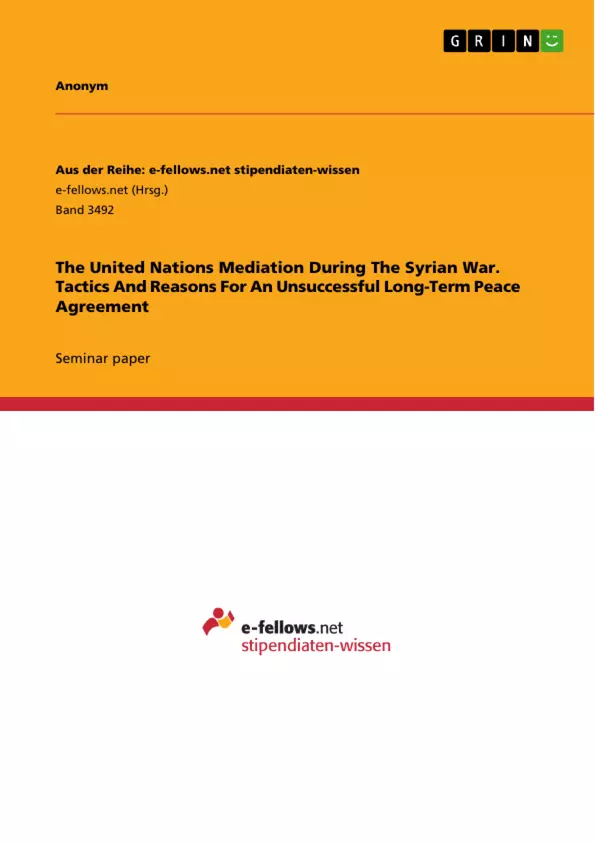This paper examines the chronology of the UN mediation launched in Syria in 2012 and the different tactics that were used by the mediators. It then analyses why the mediation was not successful at finding a long-term peace agreement. To lay the foundations, the first chapter depicts the circumstances of the war and the course of the peace process. Then a UN document is presented, which serves as a guide for successful mediation. To answer the research question, the analyses of several authors regarding the UN mediation will be summarized to find out at which point the Syrian mediation did not correspond to the guide.
In the third part of the paper, the political system of Syria is identified in an authoritarian typology. In the discussion I will reflect on whether the traditional classification is sufficient or to which extent its potential shortcomings could also represent a problematic approach to the mediation process. This would be decisive for our understanding of the failure. The conclusion will summarize the explanations as analyzed in the research field and the findings of the discussion as well as the consequences this analysis has for further research.
Inhaltsverzeichnis (Table of Contents)
- Introduction
- Methodology
- UN Mediation during the Syrian War
- Overview
- Aspects of Mediation
- State of the Art
- Syria as an Authoritarian Regime
- State of the Art
- Classification
- Discussion
- Conclusion
- References
Zielsetzung und Themenschwerpunkte (Objectives and Key Themes)
This paper aims to explore the reasons behind the failure of the UN mediation in Syria. It focuses on analyzing whether the UN's own guidelines for successful mediation were respected by the involved parties. The research delves into the specific ways in which these guidelines were neglected and the extent to which this contributed to the overall failure of the mediation process.
- Analyzing the UN's role in mediating the Syrian conflict
- Examining the adherence to the UN's own guidelines for successful mediation
- Identifying the specific shortcomings of the mediation process in Syria
- Exploring the impact of Syria's political system on the mediation effort
- Drawing conclusions about the potential for successful future mediations in similar conflicts
Zusammenfassung der Kapitel (Chapter Summaries)
- Introduction: This chapter sets the scene by outlining the devastating consequences of the Syrian War and highlighting the failure of the UN mediation efforts. It introduces the research question and the methodology employed in the paper.
- UN Mediation during the Syrian War: This chapter provides an overview of the Syrian conflict, tracing its origins and the involvement of various international actors. It outlines the key aspects of mediation and explores the state of research on UN mediation in the context of the Syrian War.
- Syria as an Authoritarian Regime: This chapter delves into the political system of Syria, examining its classification within a typology of authoritarian regimes. It explores the existing literature on authoritarianism and its potential implications for the analysis of the mediation process.
Schlüsselwörter (Keywords)
The primary focus of this paper revolves around the UN mediation in Syria, exploring its failure and the underlying factors contributing to it. The key themes include the analysis of the UN's guidelines for successful mediation, the role of the Syrian political system, the complex interplay of international actors, and the implications for future peace-building efforts in similar conflict situations. This analysis draws on existing research in the fields of international relations, conflict studies, and authoritarianism.
- Citation du texte
- Anonym (Auteur), 2019, The United Nations Mediation During The Syrian War. Tactics And Reasons For An Unsuccessful Long-Term Peace Agreement, Munich, GRIN Verlag, https://www.grin.com/document/900192



